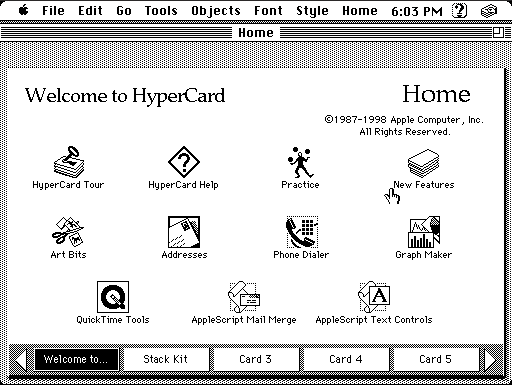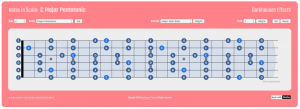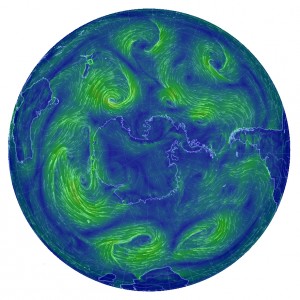This article is the first in a multi-part series related to the vintage Macintosh computers of the late 1980s, and why old software needn’t die, even if it is abandoned by its creators. ( 1 | 2 | 3 | Vintage Macintosh Resources )
I first used HyperCard in 1987, the year it was released. I last used HyperCard yesterday.

But isn’t Hypercard dead?
In the late 80s HyperCard was something to get excited about. It seemed at the time the avant-garde of computing. Perhaps it was.
HyperCard brings back a lot of memories. I remember going to a party at Amanda Goodenough’s house in the Santa Cruz hills to celebrate the success of her HyperCard storybook stacks (e.g., Inigo Gets Out). I remember meeting Todd Rundgren — one of my musical heroes — at a HyperCard conference in San Francisco, and realising I didn’t like him so much in person. HyperCard’s creator, Bill Atkinson, was the real rock star.
What was/is HyperCard? There’ve been many articles over the years; I won’t attempt to write Yet Another History. Bill Atkinson described it as programming for the rest of us, and he delivered on that promise. The rest of us included school teachers, musicians, librarians, botanists, kids. Really, anybody. Think about it. Has anything done that since? [Answer: No, not even close.]
But Apple never really knew what to do with HyperCard. Its last release was in 1998, and was finally killed off by Steve Jobs as an Apple product in 2004. But it had long languished from its heyday.
And then I didn’t think about HyperCard so much and got involved with the Web.
What was so special?
Over the years there’s been various HyperCard offshoots and derivatives (some more functional than others), but none that exactly captured that initial excitement, on a black & white 512 x 342 pixel screen. Why is that?
Part of the answer was in the limitations inherent in that tiny black & white screen and the lack of any networked connection to the outside world. Really.
The other part of the answer may be understood better by looking at the typical experience of using computers today, as well as those small computers we carry around in our pockets. That experience is exceedingly dynamic, every application and icon bright-coloured, blinking, flashing, trying desperately to get our attention. Even if they’re not making any noise, our computers are screaming at us.
If I click three times quickly on my iPhone’s button (if the setting is enabled) it converts the phone from full colour to greyscale. It’s quite an interesting experience. I don’t notice the flashing icons quite so much. I feel a bit calmer, more focused, more able to actually use the tool to get my work done. Just like in a casino, fonts, colours, shapes, movement, all are used to grab attention.
The other thing I notice about my desktop computers, laptops and phone, is that they’re always bothering me about upgrades. Are upgrades really so important? Do I need to be pestered constantly, need to sit while a Windows 10 computer or a Firefox browser stops me from getting my work done while it decides to upgrade, download, restart? Who is in charge here anyway?
Okay, enough of the rant. Point is, when you turned on a Macintosh in 1989 it was, by comparison, like entering a monastery. [Okay, maybe a monastery with a small cooling fan.] You sat in front of the machine and did some work. There were no distractions — at least not from the computer. It did what you wanted it to do. You had control. A bit like a toaster. Or maybe a bicycle…
I recently read an article by Ian Bogost in The Atlantic Monthly, where he describes his experience working on a 30-Year-Old Computer as “awesome”. I couldn’t agree more.
Part of what Bogost relates is actually about “empowerment”, which is curiously also one of the buzzwords bandied about when HyperCard was first released. Here’s the last paragraph from his article:
“As I flick off the power switch on the back of the Macintosh, the whine retreats in a gentle diminuendo, until it finally gives way to silence. I have accomplished a feat that is no longer possible: My computing session has ended.”
In this case the empowerment was the result of less is more: he’d taken control back from his computer. It somehow seems strange that we might even consider that remarkable, but those in the arts well understand that limitation can be a key to success. Yes, that 512 x 342 black & white screen was a limitation, as was the complete lack of connectivity. But some really great art has been done in ink on white paper.

Bill Atkinson remarked that had he developed HyperCard at a network-focused company like Sun Microsystems rather than at Apple, it would have likely become the first web browser. While the ramifications of that alternate reality would have truly altered the world we live in (and Bill is I think too gentle a personality to have survived the browser wars against the likes of Marc Andreessen), it’s also a poignant reminder of that quieter, non-networked, toaster-ish world we left behind. That perhaps that quieter, disconnected world of MacWrite and HyperCard was a boon.
I’m not so much of a Luddite as to want to go back, but remembering the quiet and the focus of a computer that doesn’t constantly do what it wants rather than what you want might help us all regain some of that lost empowerment.
And while I doubt too many people will actually take this advice, you still can turn off the colour, turn off the networking, and actually use a computer as a tool to get some work done. It’s easy.
In the next post I’ll talk about another article in The Atlantic, about a writer using MacWrite 4.5. I’ll also describe how I’ve been using HyperCard again in 2019, 32 years after it was first released. And yes, creating new HyperCard stacks…

